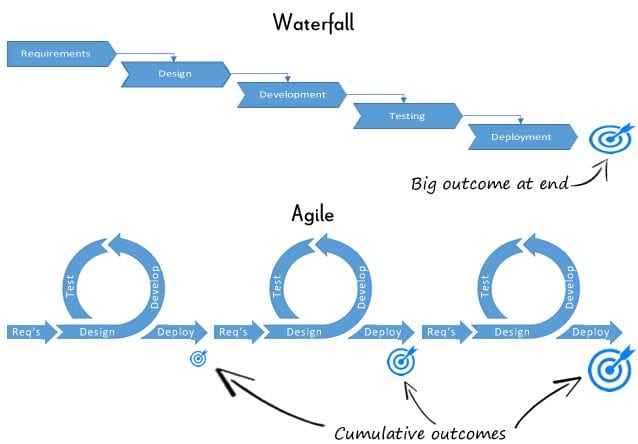What Is Agile Market Research and How Can You Get Started With It?

In February 2001, seventeen software developers formulated and signed a Manifesto for Agile Software Development which ultimately revolutionized that discipline and steadily rippled through many functional areas and industries. According to the original manifesto, an agile approach values:
- Individuals and interactions over processes and tools
- Working software over comprehensive documentation
- Customer collaboration over contract negotiation
- Responding to change over following a plan
While originated by developers, these guiding principles have been adapted by the market research industry to test, iterate, and refine research quickly. When done well, agile market research can help us reach new insights at the speed of business decisions.
What is Agile Market Research?
The agile approach is distinguished by its iterative nature. The traditional “waterfall” model begins with requirements and moves through design, development, testing, and deployment to deliver a big “Aha!” at completion. The stakes are high when defining parameters and scope at the front end, and methodological rigor can limit the ways and extent to which learnings outside the original scope can enrich the process.
The agile model starts small and proceeds in stages or “sprints”, each building on the preceding one. The outcome of each sprint informs the design and deployment of the next.

Source: Agile Research: Misconceptions and Applications, Greenbook Blog
Breaking the research process down means you can test and refine hypotheses as you go. While you revise the wording of questions, you can discard the ones that are not yielding relevant insights and add new ones. You can also include newly identified customer segments or respond to unanticipated events that potentially affect your industry or category. Each cycle must also incorporate input from the client team and from customers. By providing frequent validation of direction and scope, you will ensure results are immediately and cumulatively relevant.
In market research as in other areas, the agile approach minimizes waste of time and resources, reduces risk, and maximizes ROI.
When executed well, agile market research is typically both faster and cheaper than traditional approaches. For that reason, some market research teams mistake it for a silver bullet that controls costs or drives aggressive schedules. Resist that impulse. An agile project can deliver speed and savings, but its higher value lies in the way it balances efficiency and effectiveness.
How Do You Get Started with Agile Market Research?
As a market research professional, methodological rigor is your cake, and the agile model is all about flexibility, adaptability, and the ability to innovate as you go. So how do you find a starting point?
Begin with tight, precise scoping
Begin where you always do, with clear and careful articulation of project objectives. An agile project will be different in that objectives need to be tightly focused, with the project scope precisely defined. The iterative process works when you can make clear-cut determinations about the relevance of insights you uncover throughout the research process. It’s worth noting that the agile approach is not optimal for every research situation. Projects with broad objectives or multiple agendas may be best served by a more traditional approach.
By starting with tightly focused objectives and a precise scope, you’re able to map the iterative process in a way that lays out the sprints but leaves the content of each one flexible. Just remember, specifics will change as you incorporate what you learn into each cycle.
Create an agile team
As you assemble the project team, a few specific guiding principles will help ensure your agile projects reach their full potential.
- Map team strengths to project tasks by assigning each individual to the work that makes the highest and best use of their capabilities for that project. Focus on skills, not job titles.
- Forget hierarchy within the team. Appoint a project leader who works alongside the rest of the team while eliminating obstacles to project success and serving as point of contact with stakeholders.
- Keep the team small enough to remain agile – 8-10 members at most. If you need to scale up, add another team rather than expanding the existing one.
Ensure stakeholders are agile, too
Agile research projects also differ from traditional ones in how your internal stakeholders participate. In traditional research projects, the line manager who commissions the research is typically very involved at the front end and then largely or wholly uninvolved until it’s time to share insights. A hallmark of the agile model is close collaboration throughout the process. The stakeholder and their team should be prepared to engage with the findings during each sprint, consulting with the research team about what is learned and what it means for the next round.
For stakeholders, this represents a different way of investing time and attention and a different experience with the learning process. Stakeholders who absorb the learning as the project moves forward are much better positioned to make swift, decisive actions than stakeholders who digest all of the information and insights at the end. It’s the research team’s responsibility to make sure their stakeholders understand the value of engaging with findings during each sprint and ensure they are set up for success.
Assemble an agile toolkit
A research team is only as nimble as their available tools. Truly agile research demands user-friendly, intuitive software that enables the team to collect data, analyze it, and report findings quickly and efficiently. Don’t assume this means investing in all new platforms and programs. It may be as simple as deploying existing tools in different ways, depending on the project. Just remember to consider your toolkit as you develop your agile research strategy.
Getting Agile Research Findings in Front of Your Stakeholders
While there are likely going to be projects where it makes sense to follow more traditional research approaches, making the agile research model part of your standard operating procedures adds value to the work you do and your contribution to your company’s business goals. Because agile research moves quickly, one of the most important things to remember is to make your work and findings visible to your stakeholders so that they can stay involved along the way. If your organization uses a knowledge engagement platform, the inherently modular nature of agile research findings can be a powerful resource for stakeholders with direct or tangential interest in a specific topic.
When your agile research findings live in a knowledge engagement platform, your stakeholders can perform a keyword search or browse by custom categories that you’ve created to find the insights they need to make smart decisions. Your library of research findings will continue to grow and evolve as you conduct agile research, and your stakeholders will be able to access those findings in real time, making your insights a true competitive advantage for your company.

Enterprise AI Search: Definition, Benefits, and Evolution

The Benefit of Company-Wide Knowledge Management in 2026

Are You Making These Common Knowledge Sharing Mistakes?

Estimate the Value of Your Knowledge Assets
Use this calculator to see how enterprise intelligence can impact your bottom line. Choose areas of focus, and see tailored calculations that will give you a tangible ROI.

Take a self guided Tour
See Bloomfire in action across several potential configurations. Imagine the potential of your team when they stop searching and start finding critical knowledge.